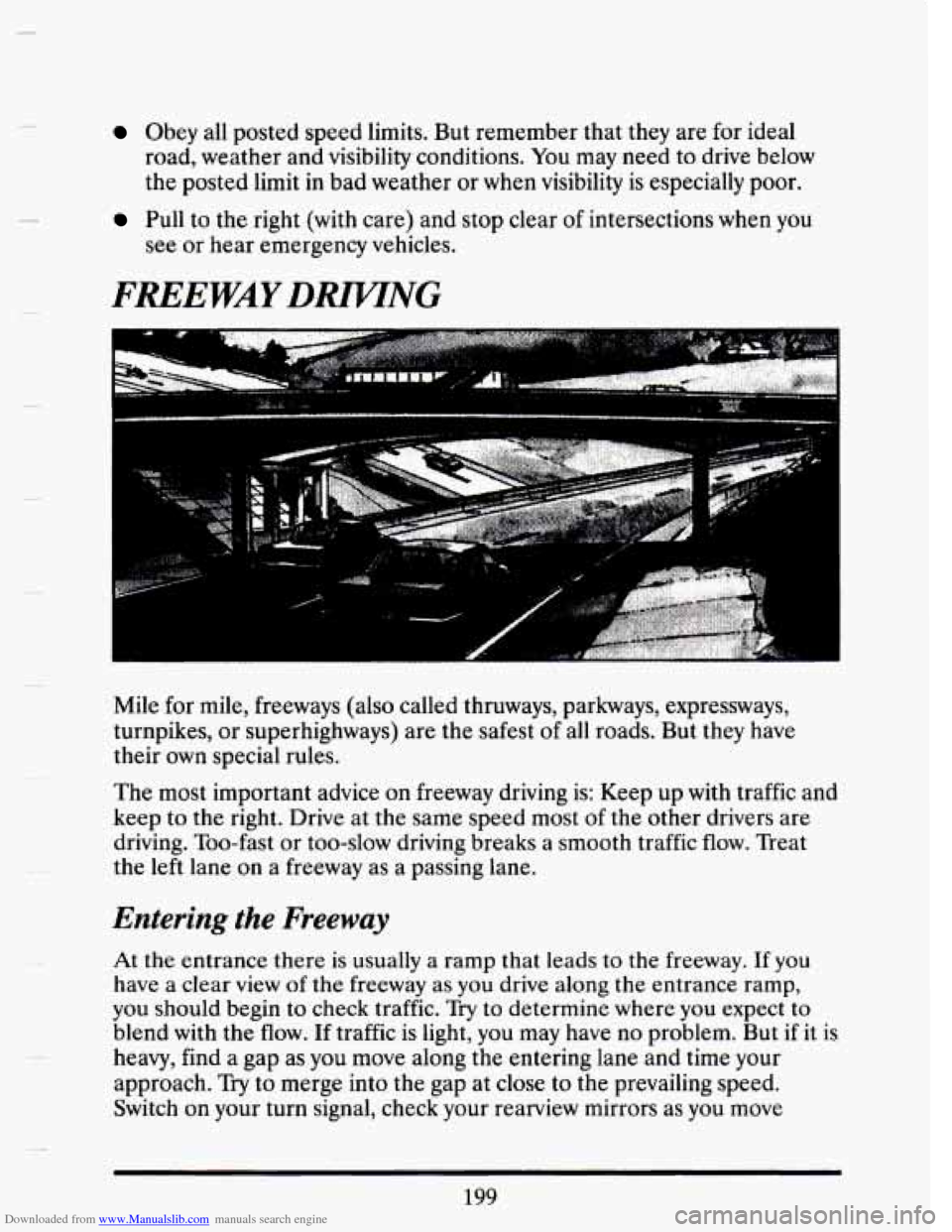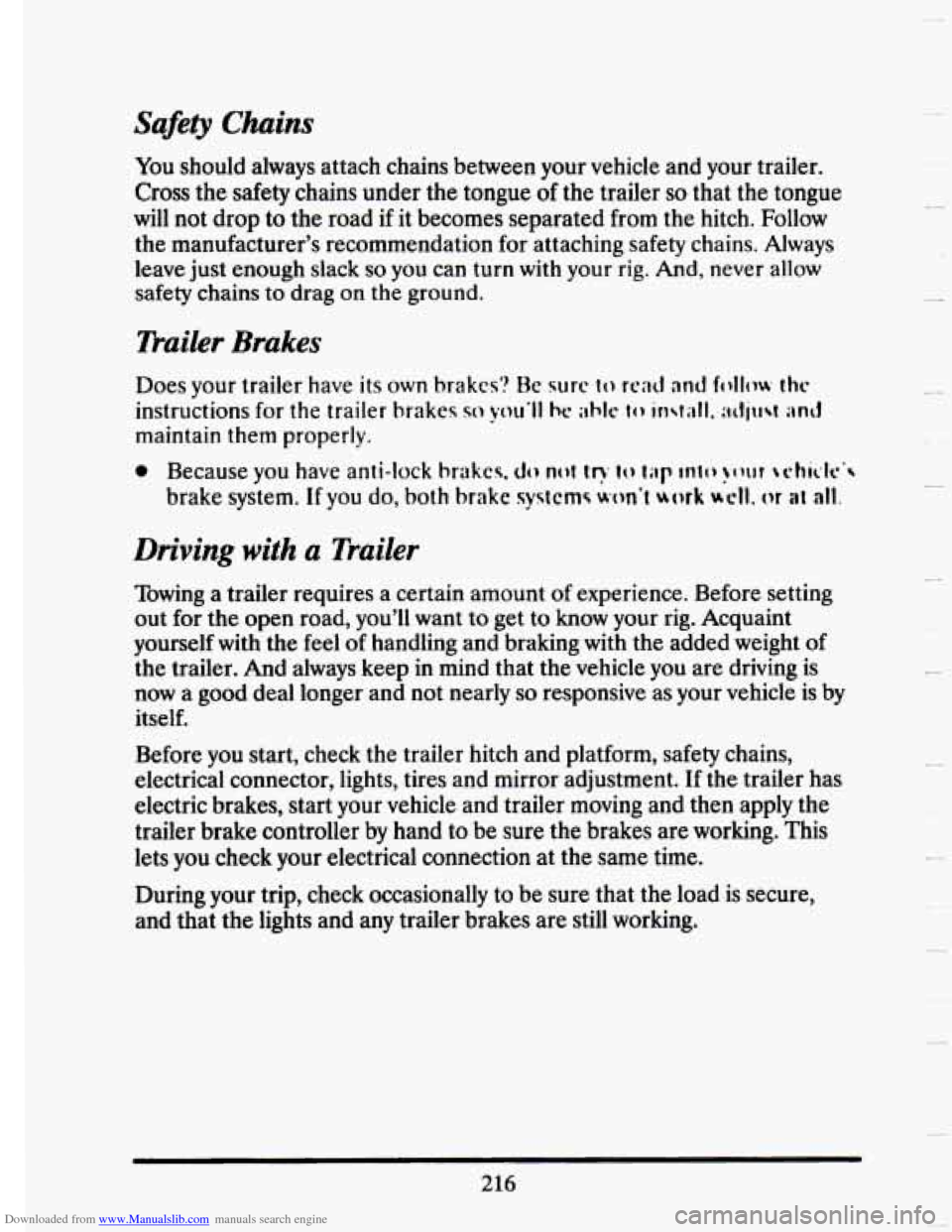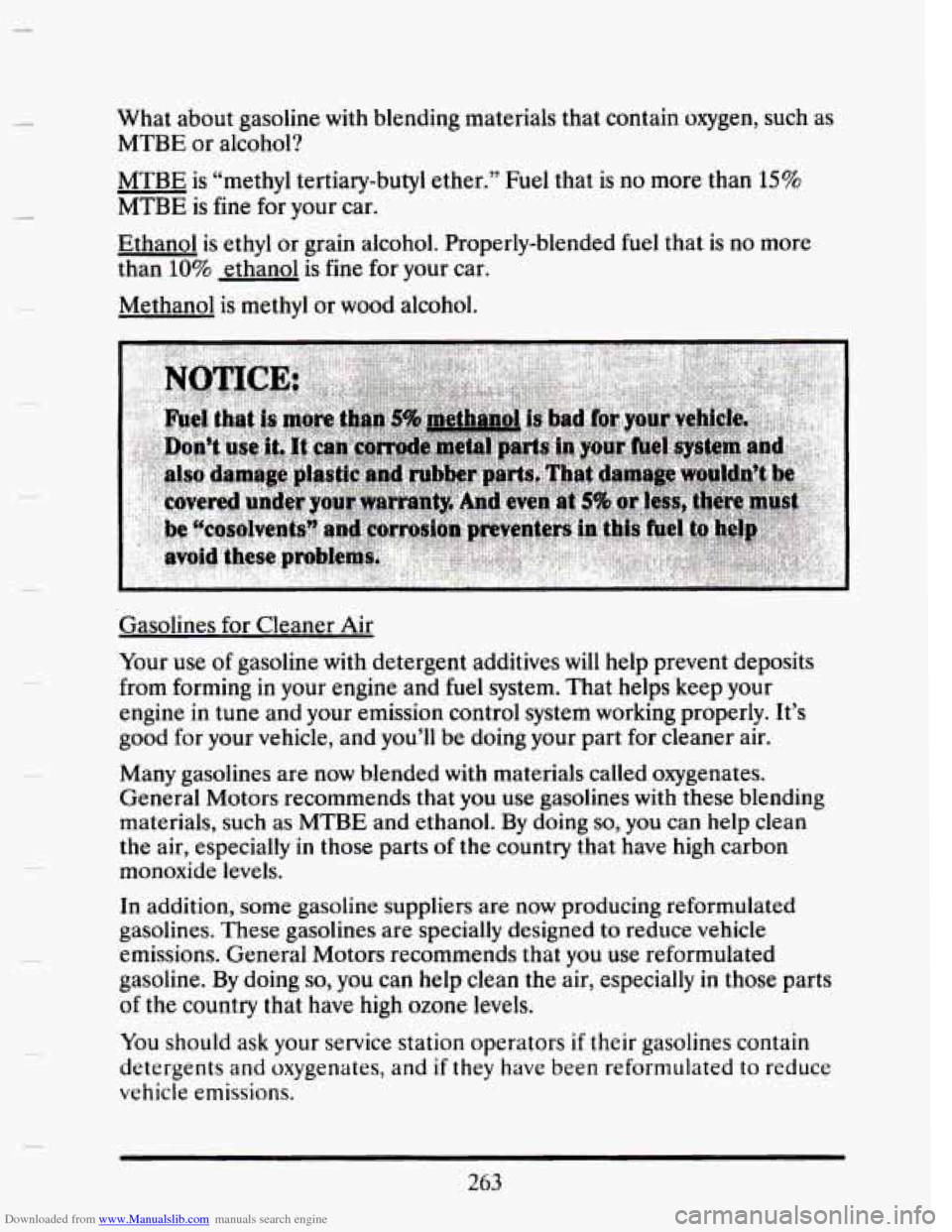Page 213 of 407

Downloaded from www.Manualslib.com manuals search engine Obey all posted speed limits. But remember that they are for ideal
road, weather and visibility conditions.
You may need to drive below
the posted limit in bad weather or when visibility
is especially poor.
Pull to the right (with care) and stop clear of intersections when you
see or hear emergency vehicles.
FREEWAY DMNG
Mile for mile, freeways (also called thruways, parkways, expressways,
turnpikes, or superhighways) are the safest
of all roads. But they have
their own special rules.
The most important advice on freeway driving is: Keep up with traffic and
keep to the right. Drive at the same speed most
of the other drivers are
driving. Too-fast or too-slow driving breaks a smooth traffic
flow. Treat
the left lane on a freeway as a passing lane.
Entering the Freeway
At the entrance there is usually a ramp that leads to the freeway. If you
have a clear view of the freeway as you drive along the entrance ramp,
you should begin to check traffic. Try to determine where you expect to
blend with the flow. If traffic is light, you may have no problem. But if it is
heavy, find
a gap as you move along the entering lane and time your
approach.
Try to merge into the gap at close to the prevailing speed.
Switch on your turn signal, check your rearview mirrors as you move
199
Page 225 of 407

Downloaded from www.Manualslib.com manuals search engine If You're Caught in a Blizzard
If you are stopped by heavy snow, you could be in a serious situation. You
should probably stay with your vehicle unless you know for sure that you
are near help and you can
hike through the snow. Here are some things
to do to summon help and keep yourself and your passengers safe: Turn
on your hazard flashers. Tie a red cloth to your vehicle to alert police that
you've been stopped by the snow. Put
on extra clothing or wrap a blanket
around you. If you have no blankets or extra clothing, make body
insulators from newspapers, burlap bags, rags, floor mats
-- anything you
can wrap around yourself or tuck under your clothing to keep warm.
You can run the engine to keep warm, but be careful.
A CAUTION
Snow can trap exhaust gases under your vehicle. This can cause
deadly
CO (carbon monoxide) gas to get inside. CO could
overcome you and
kill you. You can't see it or smell it, so you
might not know it was in your vehicle. Clear away snow from
around the base
of your vehicle especially any that is blocking
your exhaust pipe. And check around again from time to time to
be sure snow doesn't collect there.
CAUTION: (Continued)
21 1
Page 230 of 407

Downloaded from www.Manualslib.com manuals search engine Safety Chains
You should always attach chains between your vehicle and your trailer.
Cross the safety chains under the tongue
of the trailer so that the tongue
will not drop to the road if it becomes separated from the hitch. Follow
the manufacturer's recommendation for attaching safety chains. Always
leave just enough slack
so you can turn with your rig. And, never allow
safety chains to drag
on the ground.
Trailer Brakes
Does your trailer have its own brakcs'? He sure IO read and follow thc
instructions for the trailer brakes so you'll he ilblc to ir~ i~lI, ;rcliw an3
maintain them properly.
Driving with a Trailer
Towing a trailer requires a certain amount of experience. Before setting
out for the open road, you'll want to get to
know your rig. Acquaint
yourself with the feel of handling and braking with the added weight of
the trailer. And always keep
in mind that the vehicle you are driving is
now a good deal longer and not nearly so responsive as your vehicle is by
itself.
Before you start, check the trailer hitch and platform, safety chains,
electrical connector, lights, tires and mirror adjustment. If the trailer has
electric brakes, start your vehicle and trailer moving and then apply the
trailer brake controller by hand
to be sure the brakes are working. This
lets
you check your electrical connection at the same time.
During your trip, check occasionally to be sure that the load is secure,
and that the lights and any trailer brakes are still working.
216
L -4
c
L-
L-
C
Page 233 of 407
Downloaded from www.Manualslib.com manuals search engine Maintenance when Trailer Towing
Your vehicle will need service more often when you’re pulling a trailer.
See the Maintenance Schedule for more on this. Things that are
especially important
in trailer operation are automatic transaxle fluid
(don’t overfill), engine oil, axle lubricant, belts, cooling system, and brake
adjustment. Each
of these is covered in this manual, and the Index will
help you find them quickly. If you’re trailering, it’s a good idea to review
these sections before you start your trip.
Check periodically to see that all hitch nuts and bolts are tight.
219
Page 263 of 407

Downloaded from www.Manualslib.com manuals search engine . : 4. Put the cap back on
the coolant
surge
tank.
5. Start the engine and as the engine runs the coolant will circulate
through the cooling system. Any air that was introduced while adding
coolant
will purge itself and rise to the top of the surge tank. If the
“ENGINE COOLANT
LOW” message does not appear on the
Driver Information Center, coolant is at the proper
fill level. If an
“ENGINE
COOLANT LOW” message does appear, repeat steps 1
through 4 or see your dealer.
IFA TIRE GOES FLAT
It’s unusual for a tire to “blow out” while you’re driving, especially if you
maintain your tires properly. If air goes out of a tire, it’s much more likely
to leak out slowly. But if you should ever have a “blowout,” here are a
few tips about what to expect and what
to do:
If a front tire fails, the flat tire will create a drag that pulls the vehicle
toward that side. Take your foot off the accelerator pedal and grip the
steering
wheel firmly. Steer to maintain lane position, then gently brake
to a stop
well out of the traffic lane.
A rear blowout, particularly on a curve, acts much like a skid and may
require the same correction you’d use in a skid. In any rear blowout,
remove your foot from the accelerator pedal. Get the
vehicle under
control by steering the way you want the vehicle to
go. It may be very
bumpy and noisy, but you can still steer. Gently brake to a stop,
well off
the road if possible.
3
249
Page 277 of 407

Downloaded from www.Manualslib.com manuals search engine 3
What about gasoline with blending materials that contain oxygen, such as
MTBE or alcohol?
MTBE is “methyl tertiary-butyl ether.” Fuel that
is no more than 15%
MTBE is fine for your car.
Ethanol is ethyl or grain alcohol. Properly-blended fuel that is no more
than
10% ethanol is fine for your car.
Methanol is methyl or wood alcohol.
Gasolines for Cleaner Air
Your
use of gasoline with detergent additives will help prevent deposits
from forming in your engine and fuel system. That helps keep
your
engine in tune and your emission control system working properly. It’s
good for
your vehicle, and you’ll be doing your part for cleaner air.
Ivlany gasolines are now blended with materials called oxygenates.
General Motors recommends that you use gasolines with these blending
materials, such
as MTBE and ethanol. By doing so, you can help clean
the air, especially in those parts
of the country that have high carbon
monoxide levels.
In addition, some gasoline suppliers are now producing reformulated
gasolines. These gasolines are specially designed to reduce vehicle
emissions. General Motors recommends that you
use reformulated
gasoline. By doing
so, you can help clean the air, especially in those parts
of the country that have high ozone levels.
You should ask your service station operators if their gasolines contain
detergents and oxygenates, and
if they have been reformulated to reduce
ve
hide emissions.
263
Page 293 of 407
Downloaded from www.Manualslib.com manuals search engine 1“
P
Wait at least 30 minutes &ore checking the transaxle fluid level if you
have been driving:
When outside temperatures are above 90’F (32’ C).
At high speed for quite a while.
In heavy traffic -- especially in hot weather.
While pulling a trailer.
To get the right reading, the fluid should be at normal operating
temperature, which is
180°F to 200°F (82OC to 93’C).
Get the vehicle warmed up
by driving about 15 miles (24 km) when
outside temperatures are above
5O0F (loo C). If it’s colder than 5OoF
(lO°C), you
may have to drive longer.
To check the fluid level:
0
0
0
0
Park your vehicle on a level place.
Place the shift lever in
“PYy (Park) with the parking brake applied.
With your foot
on the brake pedal, move the shift lever through each
gear range, pausing
for about three. seconds in each range, Then,
position
the shift lever in “P” (Park).
L-ct Ihc cngirlr ruI1 ;II idlc for thrw to five minutes.
F
P
279
Page 295 of 407
Downloaded from www.Manualslib.com manuals search engine . ..
4.9 Liter
4.6 Liter (Northstar)
~. _,I f$<&< ...,._ : .
3. Check both sides of the dipstick, and read the lower level. The fluid
level must be in the cross-hatched area.
4. If the fluid level is where it should be, push the dipstick back in all the
How to Add Fluid:
way.
Refer to the Maintenance Schedule to determine what kind
of transaxle
fluid to
use. See “Recommended Fluids and Lubricants” in the Index.
If the fluid level is low, add only enough of the proper fluid to bring the
level into the cross-hatched area
on the dipstick. It doesn’t take much
fluid, generally
less than a pint. Don’t overfill. We recommend you use
only fluid labeled DEXRON@-IIE, because fluids with that label
are
made especially for your automatic transaxle. Damage caused by fluid
other than DEXRON@-IIE is not covered
by your new vehicle warranty.
After adding fluid, recheck the fluid level as described under “How to
Check.”
281